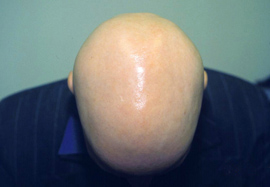

Complete loss of head hair
Alopecia totalis is complete loss of hair on the scalp (even eyebrows and eyelashes may be affected), but the rest of the body remains unaffected. Sometimes this illness is also called areata totalis. Total alopecia usually appears in two types: One is a relatively rapid with complete loss of all head hair while the other type is a slower form, which starts out as alopecia areata and ends with complete hair loss. In this sense, it is sometimes (but not always) related to alopecia areata.

Most afflicted persons are children and adults up to age 40, but the illness may occur with persons of all age categories. With this type of alopecia the afflicted persons often have deformed nails with bumps and fragile look. According to statistics 2% of males and 1% of females in Europe suffer from some form of alopecia areata. Maybe 2% of them have alopecia totalis or alopecia universalis. That means that perhaps one out of each 125,000 males and one out of each 250,000 females have alopecia totalis or alopecia universalis.
What causes total alopecia?
Alopecia totalis is an autoimmune disorder during which the immune system attacks and strikes its own hair follicles that are somehow modified, which is why the immune system identifies them as alien. In most cases there is a chance for revival of hair follicles and at least partial recovery. There have also been cases of full recovery.

